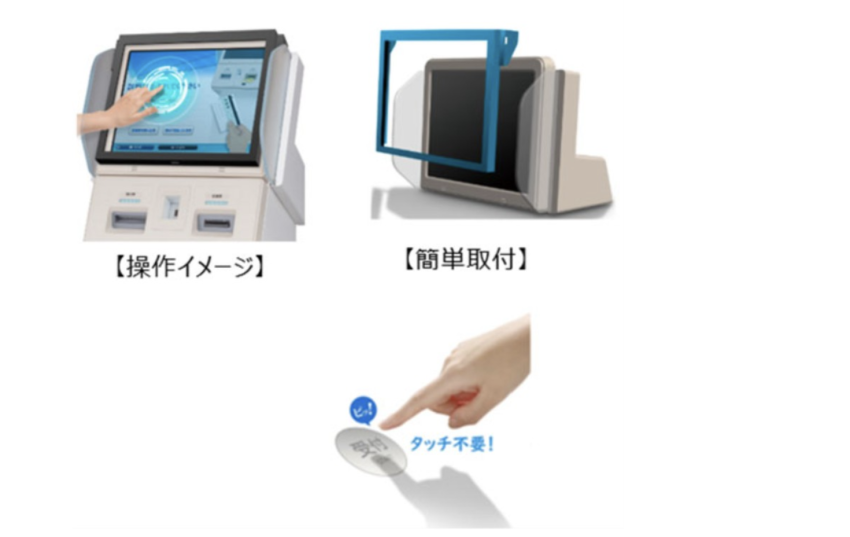The pandemic caused by the spread of the coronavirus (COVID-19) has given many a chance to revaluate their daily practices in terms of responsibility and hygiene with countermeasures consisting of social distancing and the remote handling of everything from business to chores, but certain routine actions such as touching publicly shared handles, rails, and buttons are practically unavoidable.
An idea that seems to be gaining traction in Japan for post-pandemic use is the implementation of "no-touch touch screens" which eliminate the need for direct contact when navigating screens and panels. One Japanese automotive parts manufacturer recently developed such panels using what they call "Floating Pictogram Technology" to allow users to operate button-based Japanese toilets by simply hovering their finger of the desired button on a panel.
Hospitable technology maker Almex has followed suit, having successfully developed "Contactless Frame" touch panels for use in hospitals, where they may be needed most.
Although touch panels that are touched by a large number of users are frequently disinfected by each facility to ensure maximum hygiene, there is still a possibility of transmission of germs and viruses via them.
After demonstration experiments were successfully conducted at Sanseikai Shinyurigaoka General Hospital and Koshikai Toyooka First Hospital, the non-contact frame (which function at a distance up to 30mm) will be mass produced and available for purchase to hospitals and other facilities by Almex.
As a first step, Almex will produce fittings for the APS-3300 touch panel, which they say has the most contact among touch panels, for hospitals where nosocomial infection control is urgently needed, and will sequentially develop products compatible with other medical-related equipment.
Read more stories from grape Japan.
-- Natural Japanese fashion brand nest Robe crafts clothes hangers from excess fabric
-- Thirsty cat sponges will prevent water spots and mold; may melt your heart with adorable shapes
-- Western Vtuber has real world date in Tokyo, bridging the Pacific and the virtual-real divide
- External Link
- https://grapee.jp/en/
 Take our user survey and make your voice heard.
Take our user survey and make your voice heard.




10 Comments
Login to comment
bokuda
There are much easier solutions like coating the surface or setting a UV lamp.
There are some companies overseas that offer already the anti-covid coating service for glass and furniture.
Antiquesaving
My friend is a quadriplegic has been moving his curser with his eye for years. If they can make something that tracks his eye movement it really doesn't seem so out of this world that someone could adapt that to following a hand or finger movement.
Sounds a lot more practical to make something the would do that as a hardware attachment than having to replace all the touchscreens.
Confusius
How does it differ from the technology presented by other companies though? There is for example the holographic human-machine interface Neonode (a company from Sweden) that they demoed at the Sensors Expo 2019. While they don't offer the whole unit (yet?), you can buy the infrared touch sensor already. A Chinese company called Easpeed already uses that sensor for holographic touch panels in elevators for instance.
Systems that track eye movement are usually not suitable for the tracking of hands or fingers though. Depending on the purpose you'd usually implement different kinds of technology. In some cases the reflection of infrared light on the cornea is used to calculate where someone is looking. This technology has the downside that the movement of the head can already impact the accuracy and the system has to be calibrated every time it is used. Oh, and thick glasses or makeup can also cause issues here. Other systems use diodes or contact lenses with magnet coils...so yeah, not really something I'd use for gestures.
With gestures it really comes down to the complexity of what you're trying to do with it. Often cameras alone will do the job but at some point the necessity to introduce new gestures far outweights the use of simple buttons (in cars for instance). If it is just simple things like following where your finger is pointing before you touch the screen itself, then it is already feasable with sensors (like the one I mentioned earlier). You still will have to install some hardware for that though.
commanteer
My Android phone already has this option. Nothing new at all.
mmwkdw
Gee, sounds good, but... let's see, physiologically, when we try something and it doesn't work, we try again... and I guess that will mean we touch it...
Confusius
So it's anti-Japan to point out that such technology already exists? The version from Neonode is also just a bar that can easily be added to existing devices. So they are using a frame while those that came before them only needed a bar. It's a different approach but in the end it has the same function.
But why is it that you always get so defensive when someone points out that something presented as new does already exist? This is not the first time it happened and it doesn't even matter if people link to videos that show the same technology.
virusrex
Seems a little slow taking in account the speed of development of many other things related to the pandemic, but anything that helps reducing the risk in hospitals is welcome. For COVID it seems infection because of indirect contact by touching contaminated materials with the hands is not as important as direct contact of droplets and aerosols with the airways, but in hospitals with COVID patients this is still a significant risk.